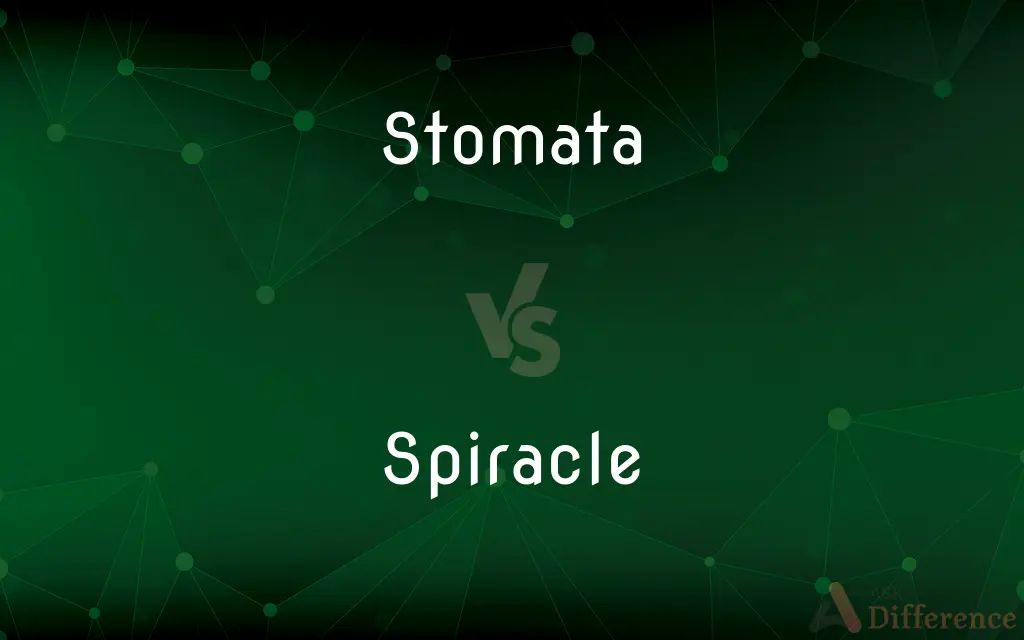Stomata vs. Spiracle — What's the Difference?
By Fiza Rafique & Urooj Arif — Updated on March 10, 2024
Stomata are microscopic openings on plant leaves essential for gas exchange, while spiracles are external respiratory openings in insects, aiding in air intake.

Difference Between Stomata and Spiracle
Table of Contents
ADVERTISEMENT
Key Differences
Stomata, found mainly on the underside of plant leaves, are crucial for photosynthesis, allowing carbon dioxide to enter and oxygen to exit. They consist of two guard cells that regulate their opening and closing, adapting to environmental conditions to maintain the plant's internal water balance. On the other hand, spiracles are found on the body of insects and some arthropods, serving as the entry point for air into the tracheal system. Spiracles can open and close to minimize water loss while ensuring that oxygen reaches the tissues and carbon dioxide is expelled.
Stomata play a significant role in transpiration, the process by which water vapor exits the plant, contributing to the movement of water and nutrients from the roots through the plant. This process also helps to cool the plant on hot days. Spiracles, in contrast, do not directly participate in the movement of fluids within the organism but are integral to the insect's respiratory system, connecting to an extensive network of tubes (tracheae) that facilitate gas exchange directly with cells.
The regulation of stomata is influenced by light, carbon dioxide concentration, and internal water pressure, reflecting the plant's need to balance gas exchange with water conservation. Spiracles are regulated by the insect's need for oxygen, with the opening and closing mechanisms controlled by muscular action or valves to prevent water loss and entry of unwanted particles.
In terms of evolutionary significance, stomata are a key adaptation in plants for life on land, enabling them to control water loss while absorbing carbon dioxide for photosynthesis. Spiracles are part of the evolutionary adaptations in insects that allow them to manage respiratory gas exchange efficiently in a terrestrial environment, providing a means to support high metabolic rates.
While both stomata and spiracles are involved in gas exchange, they serve different organisms (plants vs. insects) and have distinct structures and functions reflecting their roles in supporting life processes in their respective domains.
ADVERTISEMENT
Comparison Chart
Definition
Microscopic openings on plant leaves for gas exchange.
External respiratory openings in insects for air intake.
Location
Mainly on the underside of leaves.
On the body segments of insects.
Function
Facilitate photosynthesis and transpiration.
Aid in respiration by connecting to the tracheal system.
Regulation
Controlled by guard cells responding to environmental conditions.
Opened and closed through muscular action or valves to control air flow and minimize water loss.
Role in Water Management
Crucial for balancing water conservation with gas exchange.
Do not manage water directly but have mechanisms to reduce water loss.
Compare with Definitions
Stomata
Controlled by two guard cells.
The guard cells around the stomata deflate to close the opening during drought.
Spiracle
Connects to the tracheal system.
Oxygen travels through the spiracle into the insect's tracheae.
Stomata
Key in transpiration.
The rate of water vapor loss from the plant is regulated by the stomata.
Spiracle
Part of the insect respiratory system.
The spiracle is essential for the insect's gas exchange process.
Stomata
Vital for plant survival.
Without stomata, plants would be unable to perform photosynthesis efficiently.
Spiracle
Mechanism to minimize water loss.
The spiracle closed tightly to conserve moisture in the dry environment.
Stomata
Microscopic openings on plant leaves for gas exchange.
The stomata opened wider in response to increased light, enhancing photosynthesis.
Spiracle
Found on various body segments.
The caterpillar has spiracles along the sides of its body for breathing.
Stomata
Reflect environmental adaptation.
Desert plants have fewer stomata to reduce water loss.
Spiracle
External respiratory openings in insects.
The spiracle on the bee's abdomen opened to allow air in.
Stomata
A plural of stoma.
Spiracle
An external respiratory opening, especially each of a number of pores on the body of an insect, or each of a pair of vestigial gill slits behind the eye of a cartilaginous fish.
Spiracle
Any of several tracheal openings in the exoskeleton of an insect, spider, or other terrestrial arthropod.
Spiracle
A small respiratory opening behind the eye of most sharks and rays and certain other fishes.
Spiracle
The blowhole of a cetacean.
Spiracle
An aperture or opening through which air is admitted and expelled.
Spiracle
A pore or opening used (especially by arthropods and some fish) for respiration.
Spiracle
The blowhole of a whale, dolphin or other similar species.
Spiracle
Any small aperture or vent for air or other fluid.
Spiracle
The nostril, or one of the nostrils, of whales, porpoises, and allied animals.
Spiracle
One of the external openings communicating with the air tubes or tracheæ of insects, myriapods, and arachnids. They are variable in number, and are usually situated on the sides of the thorax and abdomen, a pair to a segment. These openings are usually elliptical, and capable of being closed. See Illust. under Coleoptera.
Spiracle
Any small aperture or vent for air or other fluid.
Spiracle
A breathing orifice
Common Curiosities
What is the primary function of stomata and spiracles?
Stomata regulate gas exchange and water vapor loss in plants, while spiracles facilitate respiration in insects.
Can the opening of stomata and spiracles be regulated?
Yes, both stomata and spiracles have mechanisms for opening and closing in response to environmental conditions.
Why are stomata mostly found on the underside of leaves?
This location minimizes water loss by reducing exposure to sun and wind.
Do all insects have spiracles?
Most insects have spiracles as part of their respiratory system, but the number and location can vary.
How do stomata and spiracles differ in structure?
Stomata consist of two guard cells on plant leaves, whereas spiracles are openings controlled by muscles or valves on insect bodies.
Are stomata found in all plants?
Most terrestrial plants have stomata, but their number and distribution can vary widely.
What evolutionary advantage do spiracles offer insects?
Spiracles allow efficient gas exchange supporting high metabolic rates, crucial for survival and activity in diverse environments.
What role does transpiration play in plant life?
Transpiration helps in nutrient transport and cooling the plant, facilitated by stomata.
How do spiracles contribute to an insect's survival in dry environments?
Spiracles can close to reduce water loss, helping insects conserve moisture.
Do stomata only open during the day?
Generally, stomata open during the day to facilitate photosynthesis but may open or close in response to other factors.
What adaptations do desert plants have regarding stomata?
Desert plants often have fewer stomata or open them at night to minimize water loss.
How do insects breathe if their spiracles are closed?
Insects temporarily close spiracles to prevent water loss but open them periodically for gas exchange.
How do guard cells function?
Guard cells swell or shrink in response to environmental cues, opening or closing the stomata accordingly.
Can spiracles get blocked?
Yes, insects may have mechanisms to clean or protect spiracles from blockage by dust or water.
What impacts the rate of transpiration in plants?
Environmental factors like temperature, humidity, and wind, as well as the number and opening of stomata, affect transpiration rates.
Share Your Discovery

Previous Comparison
Superintendent vs. Supervisor
Next Comparison
Abecedary vs. AbecedarianAuthor Spotlight
Written by
Fiza RafiqueFiza Rafique is a skilled content writer at AskDifference.com, where she meticulously refines and enhances written pieces. Drawing from her vast editorial expertise, Fiza ensures clarity, accuracy, and precision in every article. Passionate about language, she continually seeks to elevate the quality of content for readers worldwide.
Co-written by
Urooj ArifUrooj is a skilled content writer at Ask Difference, known for her exceptional ability to simplify complex topics into engaging and informative content. With a passion for research and a flair for clear, concise writing, she consistently delivers articles that resonate with our diverse audience.














































